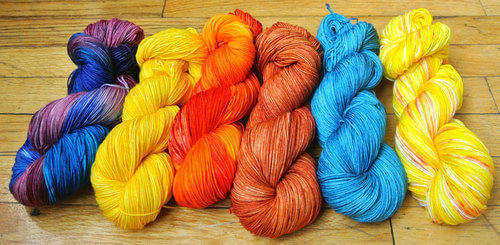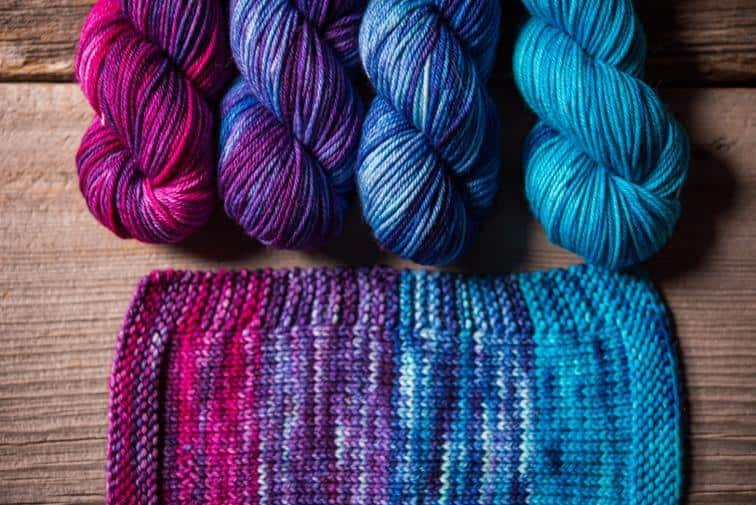How to Dye Wool : Best Dyes and Practices for Dyeing Wool Yarns and Fabrics
Before going directly to the core of the topic, I will talk about some basics of wool in brief.
One of the oldest fiber known by the human being is wool. We find wool mostly from sheep but also from alpacas, goats, and camels. Major producers of wool are Australia, Eastern Europe, New Zealand, and China.

Yarn Dyed Wool
The surface of wool is mainly a series of overlapping scales of protein. The outer surface of wool repels water, so wool remains warm even in damp weather. On the other hand, the inner layer absorbs water, and interestingly it can absorb so much that wool remains reasonably dry even if it absorbs almost double its weight. Wool is also naturally flame retardant due to its inner moisture.
Also, wool is the only natural fiber that exhibits heat of wetting, i.e., generates heat when wetted.
Learning how to dye wool will also enable you to dye other protein fibers as well since the process is pretty much the same. Keep in mind, if the dyeing process seems a bit complicated to you, you can always go for the best paint for clothes to make it easier on yourself.
Dyeing of Wool or Other Protein Fibers
Wool can be dyed in the same manner as the other animal fibers, for example, Mohair, camel’s hair, angora, and cashmere are dyed. It is because each of the animal fibers is composed of protein.
Twenty primary amino acids combine together differently to form the proteins. Cellulose made from repeating units of sugar; glucose is simpler than wool chemically. Different dyes and chemicals can create bonds with cellulose in more ways when compared to wool. However, there are many ways and many substances that are used to dye protein fibers.
Important Considerations Before Wool Dyeing
- All the animal fiber is very sensitive to alkali, or simply we can say high pH’s. That’s why soda ash, which is an essential part of cotton dyeing, should be completely avoided during wool dyeing.
- Acetic acid, citric acid, or white vinegar are part of most wool dyeing recipes.
The dyeing of wool requires heat. It can be done by,
- Applying heat to the dyebath, which contains wool, dyes, and the chemicals in a simmer or heater.
- Directly adding the dye following with setting the dye by steaming.
Due to these reasons, a dyepot is a must for wool dyeing. So, let’s talk about it in detail.
Selection of the Dye Pot
Compared to other dyeing techniques, you’ll have to be more cautious while selecting dyepots for wool dyeing. The following two factors should be given the utmost importance.
Material of the Dye Pot
You should not use aluminum dyepots as the aluminum reacts with the acid, which is an auxiliary chemical in wool dyeing. But aluminum material can be used during steaming.
As stainless steel does not react with any chemicals, it is the best choice as a dyepot. The problem is that, if you fail to dissolve salts in water thoroughly during dyeing, it may damage the stainless steel.
You can also use steel pots (canning) with enamel cover, which are also less expensive. The problem is enamel easily chips. The solution is that you can repair it easily also. Heat resistant enamel paints can be used to repair damaged enamel chips.
Size of the Dye Pot
To prevent material cramping and uneven dyeing, a large dyepot that is sufficient must be used. A dyepot in which the dyeing material can move easily and freely in water is suggested for smooth and even dyeing. Use a pot that can hold at least three gallons of liquor or more unless you dye in a very small quantity.
Now, if you dye a very small quantity, what will you do?
Just use quart-sized jars (canning). They also fill the requirement of having non-aluminum materials. You can heat the pots with a water bath. Place the pots in the water bath and cover it, check the temperature in the outer bath, when you reach your required temperature, maintain it.
Miscellaneous Equipment
- ThermometerTo keep track of temperature and maintain it perfectly, you will need a thermometer. You will find a thermometer in dye suppliers store, chemical suppliers, or local home brewing suppliers. The thermometer should cover the range from 0ºC-100ºC (32ºF − 212ºF)
- Spoons and measuring cups
- Pipettes (graduated cylinders)
- Stirrer
- Jar lifters
- Hand gloves
Selection of the Dyestuff
Acid Dye
It is the most common dye for dyeing wool and includes a wide range of various dyes. Several of those acid dyes available include food colors, Pre-metalized colors, Acid colors, Washfast Acid colors, Acid Leveling colors, and 1-shot colors.
Fiber Reactive Dyes
You may also use fiber reactive dyes found as Cibacron F, Procion MX, and Drimarene K as acid dyes on wool.
Natural Dyes
Most of the natural dyes can be easily applied to protein fibers, mainly for dyeing wool. Some may need a mordant, generally copper, alum, lead, or iron, but the problem is that they exhibit more toxicity when compared to synthetic dyestuffs.
Anyway, these dyes are easy to remove with the best dye remover for clothes as most of them tend to make weaker bonds with the fabric.
Lanaset Dyes
The Lanaset dyes are the longest living, highly resistant to wash, several hand colors available in the United States for wool dyeing. The Lanaset coloring consists of a collection of both fiber reactive dyes and acid dyes, which are built for wool. Like other wool dyes, Lanaset dyes is washable without fading badly in hot water. Often they are difficult to find in some countries.
Vinyl Sulfone Dyes
Vinyl sulfone dyes, also available as Remazol dyes, are mainly a class of fiber reactive dye, which is widely applied on silk. Like Procion MX colors, their application process is like true fiber reactive dyes, not like the acid dyes. Notice that they are marketed as:
- Vinyl Sulphon by Dharma Trading Company
- Liquid Reactive Dyes by Prochem
- Remazol dyes by other companies
Vat Dyes
Vat Dyes (Indigo also) may also be applied for wool dyeing and various protein fibers dyeing. But you must avoid high pH that may degrade the wool.
All-Purpose Dyes
These dyes are applicable for protein fibers dyeing because acid dyes are available in their mixture. The final color achieved may be faintly different than the expectation, and also the cost is higher as a high amount of dye is required.
What is the Best Dye for Wool Dyeing
We experimented with a few available dyes that are made for dyeing protein fibers like wool. The Rit all-purpose liquid dyes performed the best in terms of or vibrancy, fastness, range of shades.
To get your desired shade, you can follow our dye colour mixing guide. Just remember to check the self-shades first and adjust accordingly. However, we must warn you, it’s almost impossible to get 100% accurate hue and depth on the first try.
How to Dye Wool Fabric
There are no interchangeable dyes that can be used on wool dyeing. Many need a weak acid such as citric acid, vinegar, (NH4)2SO4, or CH3COONa, but not usually in the same quantity, and some need different other chemicals such as salt, Albegal SET, or Na2SO4.
Some colorants need a slightly lower (more acidic) pH than others; using a pH that is too low or too high for your particular coloring will limit your dyeing efficiency. Upon choosing your dye, consider a recipe for wool dyeing that specifies the specific kind of dye. The same process can be applied while learning how to dye a wool sweater.
Now, let’s talk about a method of level dyeing of wool or wool portion of a fiber blend.
- This exhaust dyeing procedure needs a strongly acidic medium, an aqueous bath of reactive dye that has a reactive group that reacts with the wool fiber under fixed conditions by nucleophilic addition reaction (Vinyl sulfonyl form).
- The temperature required for dyeing ranges from 95-106 degrees Celsius. One-step rapid dyeing is necessary. Acid or acid donating agents are no required for dye fixation.
- At dyeing temperature when the exact isothermal state for fixation of the dye is reached, incremental application of sulphuric acid for 10-45 minutes to the heated dyebath is necessary to maintain pH values between 2-3.
How to Dye Wool Yarn
A lot of hand dyeing yarn processes exist for wool dyeing. Mainly wool is dyed in package or hank form.
One common wool yarn dyeing procedure in hank form is given below. The name of the process is Short-Skein (Hank) dyeing.
- Loosely packed yarns in skeins or coils are placed over a rung and immersed in a dyebath which contains a large jar. The main advantages of this method are the best dye penetration and softer yarn. Bulky acrylic and wool yarns are mainly dyed in this method.

Dyed Wool Yarn and the Final Fabric
It seems that all dyes and pigments are colored because they usually absorb certain wavelengths of light. Unlike a dye, the pigment is usually insoluble and does not have any affinity to the substrate. Many dyes may be precipitated with an inert salt to create a pigment from the water.
Other Wool and Animal Fiber Dyeing
Different animal fibers can be dyed in this same manner using similar dyes. Fur from various mammals, alpaca, Mohair, cashmere, and angora are included in this category. Others won’t take the color as deeply as some will.
- Superwash wool can be dyed easily. The fibers soak up dye more significantly than natural wool since each fiber ‘s external layer is weakened by the chlorination, so that dye molecules can easily enter the wool fiber interior. The residual scales are trapped with a coating (resin) down into the fiber to avoid felting and shrinking.
- Smartwool is prepared by the same process, with the chlorination step being substituted by another chemical. Still, it is not known if it can be dyed easily like the superwash wool.
- Angora has the angora rabbit’s fur. With a given quantity of dye, it appears to produce paler colors than wool does.
The similar process and same dyes can be used to dye the Angora goat’s fur, Mohair. Excellently it takes dyes. During dyeing, you should not boil it but maintain a slightly lower temperature for almost an hour so that the dye molecules can easily penetrate the fiber. Generally, a temperature of not more than 82 degrees Celcius is suggested.
Shrinkage of Wool
We all know about shrinkage. Smartwool and superwash wool, for example, do not have shrinkage because they are chemically treated. Yet the wool fibers do not shorten in length themselves. Instead, the fibers become more and more tightly interlocked when exposed to heating and tension in water, with the scales that are available on the molecules of the fiber behaving like the ratchet teeth.
If preventing shrinkage and felting is necessary, you have to be careful not to agitate your wool when the wool is in the warm liquor. Stirring your dyebath frequently with cellulose fibers is required for avoiding uneven dyeing, but the dyestuffs and chemicals help wool to dye evenly without stirring,
Be wary of sudden shifts in temperature. Just slowly raise and lower the temperature of your wool. You just don’t want your wool to shake.
Using Lanaset dyes, which are washfast, when dyeing wool that can be used later for deliberate felting. Less washfast colors, when felt, can bleed.
Final Words
We didn’t have any intension to make this article any longer than it had to be. Also, we tried to cover all the aspects of how to dye wool.
If you’re interested to learn the dyeing process of nylon, then you can check out the previous post as well.
References

